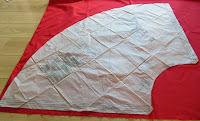 |
| Tools for the job |
Now the dilemma of what fabric to use! I wanted to get some nice tartan fabric,
 |
| Useful hints from Sandra Bardwell |
 |
| Cutting lines |
I prepared my fabric (remembering to put strips of tailors chalk on the wrong
 |
| Mark the wrong side of the fabric |
 |
| Lining up the grain |
I then double checked the instructions and realised I needed to put a 'stay stitch' in the top of the fabric to stop it from stretching. I didn't know what it was so I googled it - it is a long basting stitch that stays in - simple. So for this I set the sewing machine to a straight stitch on the longest setting and ran the stitch 1cm away from the top. Again, following the instructions I marked a 1.5cm hem down the sides with tailoring chalk in preparation for joining the pieces together and that all important invisible zip!
This is where I shall leave it today and tell you in another blog how I get on with the rest of my task! The one thing I will share is that I really enjoy the challenge this pattern is giving me! Its using the skills I have done previously plus being brave enough to try out new ones - lets hope the invisible zip comes as naturally!
Top Tips:
- Equipment: Fabric (2m) with matching zip and thread, fabric scissors, paper scissors, tailors chalk, pins, sewing pattern, sewing machine, invisible zipper foot, general purpose zipper foot and time!
- Gently press the pattern to ensure it is at its smoothest. I pressed the pattern when I ironed the fabric or iron it direct on a cool setting.
- Always look up something if you are unsure of what it means.
- Remember that the edge that is cut is not always 100% so don't pin the pattern against the edge.
- If possible, work on a large table. I don't have this luxury but I cleared a large space on my wooden floor and cut carefully around the pattern.
Useful Websites:
- Tilly and the Buttons - Stay Stitching - http://www.tillyandthebuttons.com/2013/02/stay-stitching.html
- Tilly and the Buttons - Zig Zag Stitch - http://www.tillyandthebuttons.com/2013/03/finishing-seams-zigzag-stitch.html
- The Thrifty Stitcher - http://thethriftystitcher.co.uk/
- 'All you need to know about machine and hand sewing - Sewing Basics' by Sandra Bardwell
Happy Sewing xx
No comments:
Post a Comment